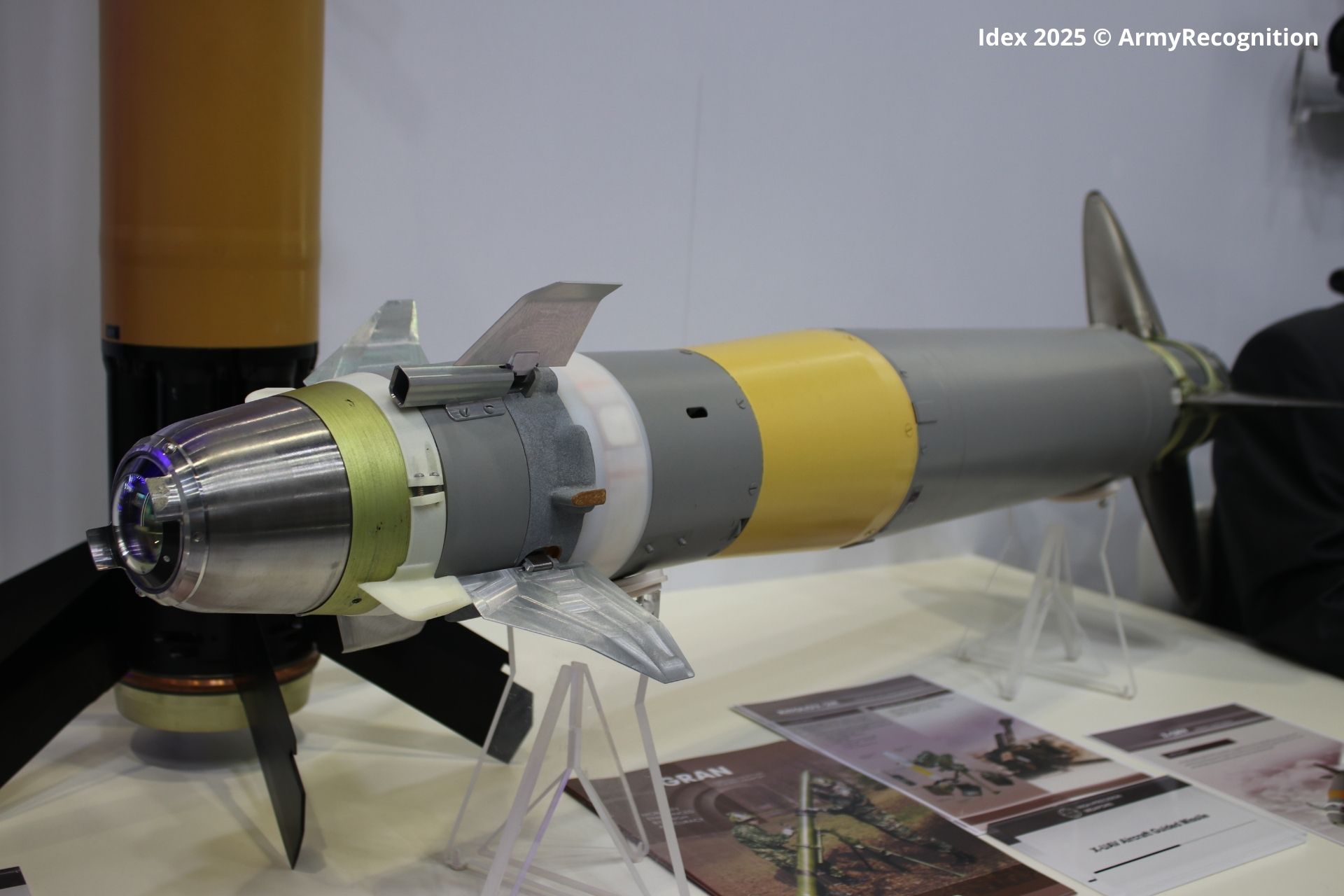Russia Enhances Drone Strike Capability With its X-UAV Air-to-Air Missile at IDEX 2025

{loadposition bannertop}
{loadposition sidebarpub}
At the IDEX 2025 exhibition in Abu Dhabi, Russia officially presents the X-UAV guided missile, an air-to-air weapon designed for remote launch from drones and helicopters, providing autonomous and precision strike capabilities against aerial and ground targets. Developed by the Tula Instrument Design Bureau (KBP), this missile is part of a strategic shift in modern weaponry, where artificial intelligence and unmanned aerial vehicles play an increasing role in military operations.
Follow Army Recognition on Google News at this link
By integrating into unmanned systems, the X-UAV enables precise strikes against low-altitude aerial targets while also being capable of engaging lightly armored or unprotected ground units. (Picture source: Army Recognition)
Also designated as the Kh-BPLA, the X-UAV is compatible with various aerial platforms, including the Orion and Forpost drones, as well as the Ka-52M attack helicopter. Its ability to engage airborne threats enhances the defensive and offensive capabilities of Russian UAVs. By integrating into unmanned systems, it enables precise strikes against low-altitude aerial targets while also being capable of engaging lightly armored or unprotected ground units.
Weighing 32 kg without a container and 42 kg when fully configured, the X-UAV uses a reflected laser beam guidance system, ensuring accuracy even in challenging combat conditions. It has an operational range between 2 and 8 kilometers, with a maximum launch altitude of 4,000 meters and an engagement angle of ±10 degrees. These characteristics provide operational flexibility, allowing drones to intercept aerial threats or engage ground targets as required.
The missile features an interchangeable warhead, allowing adaptation to different mission requirements. It includes a 6 kg high-explosive (HEF) warhead designed to inflict significant damage on aerial targets and a 3.2 kg thermobaric variant effective against fortified positions or concentrations of personnel. This modularity allows for optimized strikes based on operational needs.
The X-UAV has already been tested in real conditions. In September 2024, it was reportedly used in the Kursk region, where it destroyed a Ukrainian T-64B tank. This marked the first confirmed operational use of a drone-launched missile, highlighting the growing role of autonomous munitions in contemporary conflicts. Its air-to-air capability further extends its battlefield role, offering drones and helicopters an effective means to counter airborne threats while maintaining strike potential against ground targets.
With the development of the X-UAV, KBP positions itself as a key player in precision weaponry for drones and helicopters. The increasing use of such systems reflects a broader trend in military doctrine, where remotely operated weaponry is becoming a central element. The integration of air-to-air and air-to-ground missiles on unmanned platforms is significantly changing aerial and ground engagements, providing armed forces with more reactive and autonomous strike options. The unveiling of the X-UAV at IDEX 2025 marks a step in the evolution of guided missiles, where technology and automation continue to shape modern military strategies.

{loadposition bannertop}
{loadposition sidebarpub}
At the IDEX 2025 exhibition in Abu Dhabi, Russia officially presents the X-UAV guided missile, an air-to-air weapon designed for remote launch from drones and helicopters, providing autonomous and precision strike capabilities against aerial and ground targets. Developed by the Tula Instrument Design Bureau (KBP), this missile is part of a strategic shift in modern weaponry, where artificial intelligence and unmanned aerial vehicles play an increasing role in military operations.
By integrating into unmanned systems, the X-UAV enables precise strikes against low-altitude aerial targets while also being capable of engaging lightly armored or unprotected ground units. (Picture source: Army Recognition)
Also designated as the Kh-BPLA, the X-UAV is compatible with various aerial platforms, including the Orion and Forpost drones, as well as the Ka-52M attack helicopter. Its ability to engage airborne threats enhances the defensive and offensive capabilities of Russian UAVs. By integrating into unmanned systems, it enables precise strikes against low-altitude aerial targets while also being capable of engaging lightly armored or unprotected ground units.
Weighing 32 kg without a container and 42 kg when fully configured, the X-UAV uses a reflected laser beam guidance system, ensuring accuracy even in challenging combat conditions. It has an operational range between 2 and 8 kilometers, with a maximum launch altitude of 4,000 meters and an engagement angle of ±10 degrees. These characteristics provide operational flexibility, allowing drones to intercept aerial threats or engage ground targets as required.
The missile features an interchangeable warhead, allowing adaptation to different mission requirements. It includes a 6 kg high-explosive (HEF) warhead designed to inflict significant damage on aerial targets and a 3.2 kg thermobaric variant effective against fortified positions or concentrations of personnel. This modularity allows for optimized strikes based on operational needs.
The X-UAV has already been tested in real conditions. In September 2024, it was reportedly used in the Kursk region, where it destroyed a Ukrainian T-64B tank. This marked the first confirmed operational use of a drone-launched missile, highlighting the growing role of autonomous munitions in contemporary conflicts. Its air-to-air capability further extends its battlefield role, offering drones and helicopters an effective means to counter airborne threats while maintaining strike potential against ground targets.
With the development of the X-UAV, KBP positions itself as a key player in precision weaponry for drones and helicopters. The increasing use of such systems reflects a broader trend in military doctrine, where remotely operated weaponry is becoming a central element. The integration of air-to-air and air-to-ground missiles on unmanned platforms is significantly changing aerial and ground engagements, providing armed forces with more reactive and autonomous strike options. The unveiling of the X-UAV at IDEX 2025 marks a step in the evolution of guided missiles, where technology and automation continue to shape modern military strategies.




